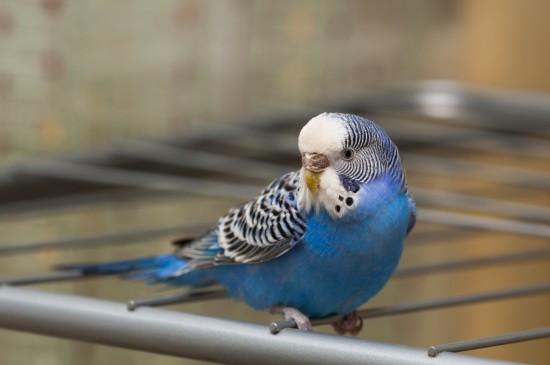

Birds use the same senses that we use on a daily basis; sight, hearing, taste, touch and smell and they use them as often as we do. However due to the physical shape and size of birds they use them in different ways to we do.
Good eyesight is crucial for birds, especially for flying but also for locating food, avoiding becoming food for predators and finding themselves a mate. The degree to which any species relies on its sight is evident by the size of the eye in relation to the rest of the body; in humans, our eyes take up around 1% of the weight of our head. For some birds, the weight of two eyes is greater than that of their brain. And in comparison with humans, a bird’s optic lobe of the brain is better developed and larger.
The position of the eyes in the head, the shape of the eyeball, as well as the ability to quickly focus and regulate for light levels all contribute to why birds have such good eye sight. A bird’s eye reacts to changes in light around twice as fast as the eye of a 20-year-old human. The lens of the eye is also very flexible, meaning they can change focus from near to far very quickly so they can spot their food while flying and quickly swoop in to grab it.
Colour vision isn’t the same for all birds so some have the ability to see in colour while others don’t. However, some species can see colours that humans cannot such as ultraviolet light. This ability is thought to be connected to the selecting of a mate.
Birds also have a special way to protect their precious eyes when they are in flight – a third eyelid known as the nictitating membrane. This is clear so the birds can see through it but protects the eye when in flight and can also allow them to ‘blink’ and clear away any debris. The normal eyelids are only visible when the bird is asleep.
Most species of bird have their ears located just behind and below the eye and their ears are hidden by special feathers known as ear coverts. These feathers are a different texture to other head features and if they are gently moved aside, the opening of the outer ear can be seen. Sound is captured by the outer ear and then travels through the middle to the inner ear, which then passes the signals to the brain for interpretation.
Birds can suffer an injury or infection to the outer ear that can affect their hearing. Macaws for example that have had a stunted start to their lives can have scarring or infections to the outer ear that leaves them with hearing problems later in life. Lovebirds are a species most prone to ear infections but any type of bird can suffer from it. Regularly checking a bird’s ears to make sure there are no signs of inflammation or debris accumulation can help prevent this. If the outer ear tissue is reddened, you should take the bird to a vet.
As well as the hearing element, the middle ear also works on sensory information needed for balance and equilibrium, much as it does in humans.
Many species of birds have excellent hearing but they don’t hear over as broad a range of sounds as humans do. What they don’t have in range, they make up for with the ability to distinguish the smallest change in pitch and beat. An owl can sense rapid fluctuations 10 times more accurately than humans can and some owls use this to find prey, even when there is no light at all.
Hearing song helps birds to find mates, keep away from danger, lay out their territory and chat to other flock members. Pet birds will use the same traits with humans and the world they occupy and this is why it is normal for them to vocalise to things they hear around them, even if it a refrigerator or a mobile phone. In the same way, this is how they learn to mimic human speech and learn to almost talk to people, repeating things they have heard repeatedly together to almost form a conversion of sorts.
Research in the last 20 years has shown that, while birds’ sense of smell isn’t as good as others, they do use it for feeding and also for navigation. Birds such as sea birds and vultures use their sense of smell to find food while pet birds often use it to select their favourite food from a selection. Smell is also important for navigation – homing pigeons use smell to find their home nests as when the bird nostrils were plugged in an experiment, they were unable to find their way home.
Taste is believed to be similar to the sense in humans. Taste buds are at the back of the tongue and the bottom of the throat and they have fewer than humans do. Species such as parrots and hummingbirds have a fine sense of sweet and sour foods due to them eating fruit and nectar while birds who eat mostly seeds don’t seem to notice the difference. Birds can sense the salt levels in food and will avoid bitter tasting food. A study in 2004 on caged cockatiels also said that birds could taste when to avoid eating something with harmful chemicals in, though not something anyone would want to test on their birds!
Bird’s skin has nerve endings that send information to the brain about the environment they are in and are aware of pain and injury just the same as humans so. Some species have sensory feathers around the eyes, mouth and nostrils while others have nerve endings called herbst corpuscles on the end of the bill or beak or the tongue on smaller birds. There are also sensory cells on the base flight feathers.
 Blood-sugar Monitoring And Anomalies In The Diabetic Dog
Blood-sugar Monit
Blood-sugar Monitoring And Anomalies In The Diabetic Dog
Blood-sugar Monit
 Lifetime Costs Of Dog Ownership
Lifetime Costs Of
Lifetime Costs Of Dog Ownership
Lifetime Costs Of
 Pet Boarding Chapel Hill: Safe Place for a Pet
Pet Boarding Chapel Hill: Safe Place for a Pet
Pet Boarding Chapel Hill: Safe Place for a Pet
Pet Boarding Chapel Hill: Safe Place for a Pet
 Pet Loss, the Inspirational Story of My Dog Companions
Pet Loss, the Inspirational Story of My Dog Companions
 Urinary Incontinence In Dogs
Urinary Incontine
Urinary Incontinence In Dogs
Urinary Incontine
Copyright © 2005-2016 Pet Information All Rights Reserved
Contact us: www162date@outlook.com